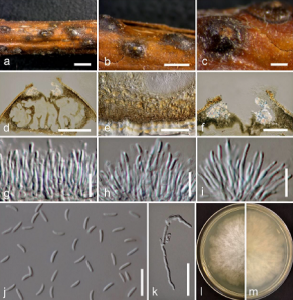Cytospora donetzica Norphanphoun, Bulgakov, T.C. Wen & K.D. Hyde, sp. nov., Index Fungorum number: IF552603
Etymology: The specific epithet “donetzica” refers to biogeographical region of Donets ridge (Donets highland) and Seversky Donets river basin, where the type specimens were collected.
Holotype: MFLU 15-2093
Associated with twigs and branches of Crataegus monogyna Jacq., Pyrus pyraster (L.) Burgsd., Rosa sp. and Salix alba. Sexual morph: Undetermined. Asexual morph: Conidiomata 800–1200 × 480–560 μm diameter, semi-immersed in host tissue, scattered, with 3–4 locules, with ostiolate. Ostioles 150–250 μm diameter, at the same level as the disc surface. Peridium comprising a few to several layers of cells of textura angularis, with inner most layer thin, pale brown, outer later brown. Conidiophores branched, reduced to conidiogenous cells. Conidiogenous cells blastic, enteroblastic, phialidic, formed from the inner most layer of pycnidial wall, hyaline, smooth-walled. Conidia (4.6–)5.4–6.4 ×1.2–1.4(–1.6) μm (x̅ = 5.5 × 1.4 μm, n = 30), unicellular, elongate-allantoid, slightly curved, hyaline, smooth-walled.
Culture characteristics – Colonies on MEA, reaching 7 cm diameter after 7 days at 25 °C, producing dense mycelium, circular, margin rough, white, with aerial mycelium.
Distribution: Shakhty City, Rostov Region, Russia.
Host: On dead and dying branches of Rosa sp.
Material examined – RUSSIA, Rostov Region, Shakhty City, Grushevka steppe slopes near Grushevsky pond, ravine shrubbery, on dead and dying branches of Rosa sp. (Rosaceae), 14 May 2015, T. Bulgakov, T-389 (MFLU 15-2093, holotype, KUN, isotype), ex-type living culture, MFLUCC 16-0574, KUMCC; RUSSIA, Rostov Region, Krasnosulinsky District, Donskoye forestry, stony steppe, on dead and dying branches of Crataegus monogyna (Rosaceae), 28 June 2015, T. Bulgakov, T-523 (MFLU 15-2227, KUN), living culture, MFLUCC 15-0864, KUMCC; RUSSIA, Rostov Region, Krasnosulinsky District, Donskoye forestry, riparian forestry, on dead and dying branches of Salix alba (Salicaceae), 18 June 2015, T. Bulgakov, T-343 (MFLU 15-2047, KUN), living culture, MFLUCC 16-0589, KUMCC; RUSSIA, Rostov Region, Krasnosulinsky District, Donskoye forestry, ravine forest, on dying twigs and branches of Pyrus pyraster (Rosaceae), 27 October 2015, T. Bulgakov, T-1102 (MFLU 15-3764, KUN), living culture, MFLUCC 16-0641, KUMCC.
Notes: We observed four isolates of Cytospora donetzica (MFLUCC 16-0574, MFLUCC 15-0864, MFLUCC 16-0589, MFLUCC 16-0641) which clustered on a relative independent branch with high bootstrap support (100% MP/ 100% ML/ 1.00 PP, Fig. 2). The new species is introduced with the type from Rosa sp. Cytospora donetzica is most similar to C. ceratosperma (Tode) G.C. Adams & Rossman in its conidia size (5.5 × 1.4 μm versus 5–6 × 1.4 μm) (Saccardo 1884). However, based on combined gene phylogenetic analysis, C. donetzica is clearly separated from C. ceratosperma and sister to C. sorbicola with high bootstrap support (86% MP/76% ML/0.98 PP) (Fig. 2). In the polymorphic nucleotides of ITS, RPB2 and ACT sequence data, C. donetzica differs from C. sorbicola with five ITS polymorphisms, 23 RPB2 polymorphisms and seven ACT polymorphisms. Thus, C. donetzica is considered as a novel species.
FIG. Cytospora donetzica on Rosa sp. (MFLU 15-2093, holotype). a Stromatal habit in wood. b Fruiting bodies on substrate. c Surface of fruiting bodies. d Cross section of the stroma showing conidiomata. e Peridium. f Ostioles. g–i Conidiogenous cells with attached conidia. j Mature conidia. k Germinating spore. l, m Colonies on MEA (l-from above, m-from below). Scale bars: a = 2000 μm, b = 1000 μm, c, d = 500 μm, f = 200 μm, e, k = 50 μm, g–j = 10 μm.

